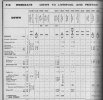By the early 1980s, after years of the WCML track being hammered to death by 86s running at 100 mph, TSRs were rife, the track condition was poor, and the ride was notoriously rough. Alarmingly, the number of broken rails was increasing sharply. Over several years a campaign of "daytime patrolling" by p.way staff was used to bring the condition of the track back up to scratch. After the passage of the key morning WCML Peak services, possessions would be taken (on a rotating cyclical basis) of either the Up Fast, Up Slow, Down Fast, of Down Slow between nominated junctions, so that the PW Engineers could walk the track in daylight and fettle it as required. Obviously this meant a certain degree of flexibility was needed in the timetabling, as the possession site might be (say) Willesden Jn to Harrow on Monday, Harrow to Watford on Tuesday, Watford to Kings Langley on Wednesday, etc. So there was a "timetabled weave" allowance put into the off-peak services, allowing for one Fast - Slow - Fast weave to take place. I can't remember the exact value - it might have been 8 - 10 minutes in every train. Whilst the spotlight was on the track maintenance staff, the signallers really had to be on the top of their game too, as their "working norms" were changing from day to day, and the ability to foresee junction conflicts and regulate accordingly became a key skill. It took several years, and the rebuilding of the 86s and restriction of Roarers to 80 mph to give the WCML a chance of recovering to a decent standard of track. Arguably this only papered over the cracks until the West Coast Route Modernisation and Virgin Pendolinos came along, which included a full scale rebuilding of many long-damaged track sections..

